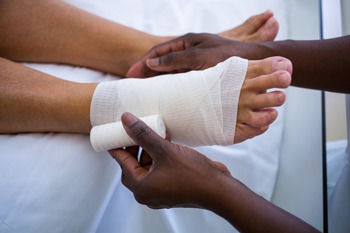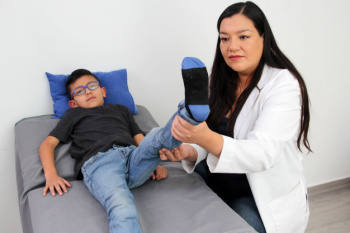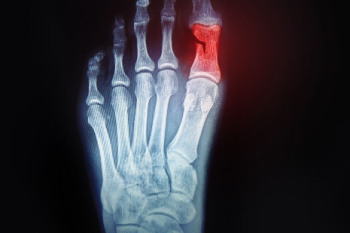Items filtered by date: April 2024
Treatment of Gangrene

For individuals with diabetes, the development of gangrene poses serious health risks and requires prompt treatment to prevent further complications. Gangrene results from necrosis, or death of body tissue in the lower legs and feet. Treatment for gangrene in diabetic patients involves a multifaceted approach aimed at halting tissue necrosis, controlling infection, and promoting wound healing. Surgical debridement is essential to remove any dead tissue and prevent further spread. Antibiotic therapy is used for managing bacterial infections associated with gangrene, often administered intravenously for severe cases. Restoring blood flow to the affected area through bypass surgery or angioplasty can help prevent tissue necrosis and reduce the need for amputation. Hyperbaric oxygen therapy delivers high-pressure oxygen to promote healing and control infection. Reconstructive surgery with skin grafts may be necessary to restore tissue integrity in extensively damaged areas. In severe cases, amputation may be required to prevent the spread of gangrene and facilitate prosthetic limb fitting. Throughout this treatment journey, podiatrists play a vital role in wound care, offering specialized expertise in diabetic foot care and wound management. If gangrene is a threat, it is suggested that you schedule an immediate appointment with a podiatrist for wound care and a prognosis.
Wound care is an important part in dealing with diabetes. If you have diabetes and a foot wound or would like more information about wound care for diabetics, consult with Derek Smith, DPM from Oklahoma. Our doctor will assess your condition and provide you with quality foot and ankle treatment.
What Is Wound Care?
Wound care is the practice of taking proper care of a wound. This can range from the smallest to the largest of wounds. While everyone can benefit from proper wound care, it is much more important for diabetics. Diabetics often suffer from poor blood circulation which causes wounds to heal much slower than they would in a non-diabetic.
What Is the Importance of Wound Care?
While it may not seem apparent with small ulcers on the foot, for diabetics, any size ulcer can become infected. Diabetics often also suffer from neuropathy, or nerve loss. This means they might not even feel when they have an ulcer on their foot. If the wound becomes severely infected, amputation may be necessary. Therefore, it is of the upmost importance to properly care for any and all foot wounds.
How to Care for Wounds
The best way to care for foot wounds is to prevent them. For diabetics, this means daily inspections of the feet for any signs of abnormalities or ulcers. It is also recommended to see a podiatrist several times a year for a foot inspection. If you do have an ulcer, run the wound under water to clear dirt from the wound; then apply antibiotic ointment to the wound and cover with a bandage. Bandages should be changed daily and keeping pressure off the wound is smart. It is advised to see a podiatrist, who can keep an eye on it.
If you have any questions, please feel free to contact our offices located in Ponca City, and Stillwater, OK . We offer the newest diagnostic and treatment technologies for all your foot care needs.
Get Proper Treatment for Ankle Injuries
Common Foot Problems Among Children

Understanding your child's foot problems is important for early detection and intervention. Sever’s disease, medically known as calcaneal apophysitis, usually affects children ages eight to 14, especially those who are physically active. It is caused by inflammation of the heel growth plate and aggravated by repetitive stress from sports participation. Ingrown toenails in children often result from wearing ill-fitting shoes paired with improper nail cutting. Treatment from a podiatrist and proper shoe fitting changes may be necessary. Intoeing, characterized by walking with inward-turned feet, may require stretching exercises or casting under the guidance of a podiatrist. Metatarsus adductus is a congenital foot deformity that causes the front half of the foot, or forefoot, to turn inward, but typically resolves itself without treatment. However, regular visits to a podiatrist for monitoring are suggested. Pediatric flat feet, while common in babies and toddlers, may warrant intervention to ensure proper arch development if the arch fails to appear with growth. Plantar warts, caused by the human papillomavirus, or HPV, can be painful and affect mobility. If your child has any of these conditions, it is suggested that you schedule an appointment with a podiatrist for periodic exams and treatment as needed.
Making sure that your children maintain good foot health is very important as they grow. If you have any questions, contact Derek Smith, DPM of Oklahoma. Our doctor can provide the care you need to keep you pain-free and on your feet.
Keeping Children's Feet Healthy
Having healthy feet during childhood can help prevent medical problems later in life, namely in the back and legs. As children grow, their feet require different types of care. Here are some things to consider...
Although babies do not walk yet, it is still very important to take care of their feet.
Avoid putting tight shoes or socks on his or her feet.
Allow the baby to stretch and kick his or her feet to feel comfortable.
As a toddler, kids are now on the move and begin to develop differently. At this age, toddlers are getting a feel for walking, so don’t be alarmed if your toddler is unsteady or ‘walks funny’.
As your child gets older, it is important to teach them how to take care of their feet.
Show them proper hygiene to prevent infections such as fungus.
Be watchful for any pain or injury.
Have all injuries checked by a doctor as soon as possible.
Comfortable, protective shoes should always be worn, especially at play.
If you have any questions please feel free to contact our offices located in Ponca City, and Stillwater, OK . We offer the newest diagnostic and treatment technologies for all your foot and ankle needs.
Causes and Treatment of Foot Drop

Foot drop is a condition characterized by the inability to lift or move the foot and toes. It is characterized by the failure to clear the ground when you take a step, forcing the need to have a marching gait when walking. Foot drop typically results from nerve injury, such as sports injuries, keeping the legs in one position for a long time, or peripheral neuropathy. Certain surgeries, including hip or knee replacements, also may increase the risk of foot drop. Treatment approaches vary, depending on the underlying cause and the duration of the condition. Exercises to strengthen and stretch the muscles of the leg and foot can help to improve mobility. Additionally, braces, splints, or custom orthotic shoe inserts can provide support and maintain proper foot alignment. In some cases, electrical nerve stimulation devices may be employed to aid nerve function. Surgical interventions, such as joint fusion or nerve repair, may be considered for those with permanent impairment. For help with managing foot drop, it is suggested that you schedule an appointment with a podiatrist for a full examination and an accurate diagnosis to determine what the proper treatment is for you.
If you have any concerns about your feet, contact Derek Smith, DPM from Oklahoma. Our doctor can provide the care you need to keep you pain-free and on your feet.
Biomechanics in Podiatry
Podiatric biomechanics is a particular sector of specialty podiatry with licensed practitioners who are trained to diagnose and treat conditions affecting the foot, ankle and lower leg. Biomechanics deals with the forces that act against the body, causing an interference with the biological structures. It focuses on the movement of the ankle, the foot and the forces that interact with them.
A History of Biomechanics
- Biomechanics dates back to the BC era in Egypt where evidence of professional foot care has been recorded.
- In 1974, biomechanics gained a higher profile from the studies of Merton Root, who claimed that by changing or controlling the forces between the ankle and the foot, corrections or conditions could be implemented to gain strength and coordination in the area.
Modern technological improvements are based on past theories and therapeutic processes that provide a better understanding of podiatric concepts for biomechanics. Computers can provide accurate information about the forces and patterns of the feet and lower legs.
Understanding biomechanics of the feet can help improve and eliminate pain, stopping further stress to the foot.
If you have any questions please feel free to contact our offices located in Ponca City, and Stillwater, OK . We offer the newest diagnostic and treatment technologies for all your foot and ankle needs.
Healing Time for a Broken Toe

A broken toe, often caused by accidents like dropping heavy objects on it or colliding with furniture, can result in significant discomfort and affect daily activities. Typically, treatment involves immobilizing the toe by taping it to an adjacent one. In more severe cases, casting or surgery may be required, especially if multiple toes or the big toe are affected. The average healing time for a broken toe ranges from six to eight weeks, but several factors can influence this duration. The extent of the injury, the number of joints involved, and any accompanying damage, such as ligament injuries, all play a role in the recovery timeline. Upon seeking medical attention from a podiatrist, an X-ray is generally conducted to assess the severity of the fracture and guide treatment decisions. For hairline fractures, rest and limited weight-bearing suffice, while splinting may be necessary for more severe cases. The use of crutches may be prescribed to alleviate pressure on the foot. If healing progresses slowly or complications arise, it is suggested that you schedule an appointment with a podiatrist for further evaluation and specialized care.
A broken toe can be very painful and lead to complications if not properly fixed. If you have any concerns about your feet, contact Derek Smith, DPM from Oklahoma. Our doctor will treat your foot and ankle needs.
What to Know About a Broken Toe
Although most people try to avoid foot trauma such as banging, stubbing, or dropping heavy objects on their feet, the unfortunate fact is that it is a common occurrence. Given the fact that toes are positioned in front of the feet, they typically sustain the brunt of such trauma. When trauma occurs to a toe, the result can be a painful break (fracture).
Symptoms of a Broken Toe
- Throbbing pain
- Swelling
- Bruising on the skin and toenail
- The inability to move the toe
- Toe appears crooked or disfigured
- Tingling or numbness in the toe
Generally, it is best to stay off of the injured toe with the affected foot elevated.
Severe toe fractures may be treated with a splint, cast, and in some cases, minor surgery. Due to its position and the pressure it endures with daily activity, future complications can occur if the big toe is not properly treated.
If you have any questions please feel free to contact our offices located in Ponca City, and Stillwater, OK . We offer the newest diagnostic and treatment technologies for all your foot and ankle needs.
How Aging Can Affect Women’s Feet

As women age, their feet undergo various changes that can affect their comfort and mobility. Menopause-induced hormonal shifts often lead to dry, calloused skin, making the feet susceptible to painful fissures and infections. Weight gain in middle age can weaken the arches, causing conditions like plantar fasciitis. The loss of fat padding on the balls of the feet and heels can result in metatarsalgia and heel pain, especially for those who spent years wearing high heels. Additionally, arthritis of the big toe joint, known as hallux rigidus, can cause pain and stiffness with each step. Bunions, caused by genetic factors and years of wearing narrow-toed shoes, are also common causes of foot pain in older women. To address these issues and maintain foot health, women over 50 need to prioritize regular foot care and wear supportive footwear. However, if foot pain persists or worsens, it is suggested that you make an appointment with a podiatrist for personalized treatment and care.
Proper foot care is something many older adults forget to consider. If you have any concerns about your feet and ankles, contact Derek Smith, DPM from Oklahoma. Our doctor can provide the care you need to keep you pain-free and on your feet.
The Elderly and Their Feet
As we age we start to notice many changes in our body, but the elder population may not notice them right away. Medical conditions may prevent the elderly to take notice of their foot health right away. Poor vision is a lead contributor to not taking action for the elderly.
Common Conditions
- Neuropathy – can reduce feeling in the feet and can hide many life-threatening medical conditions.
- Reduced flexibility – prevents the ability of proper toenail trimming, and foot cleaning. If left untreated, it may lead to further medical issues.
- Foot sores – amongst the older population can be serious before they are discovered. Some of the problematic conditions they may face are:
- Gouging toenails affecting nearby toe
- Shoes that don’t fit properly
- Pressure sores
- Loss of circulation in legs & feet
- Edema & swelling of feet and ankles
Susceptible Infections
Diabetes and poor circulation can cause general loss of sensitivity over the years, turning a simple cut into a serious issue.
If you have any questions please feel free to contact our offices located in Ponca City, and Stillwater, OK . We offer the newest diagnostic and treatment technologies for all your foot and ankle needs.

